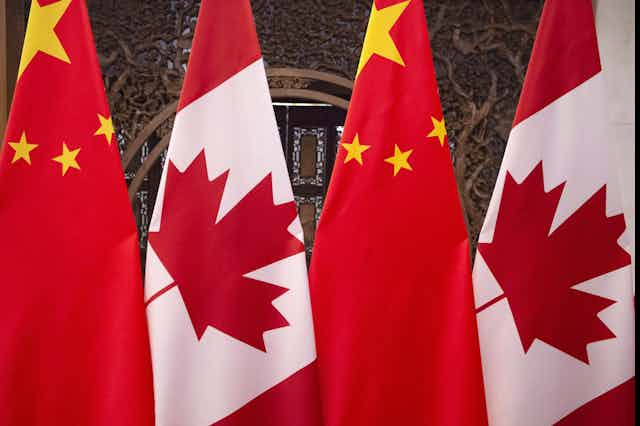It’s now confirmed that Prime Minister Justin Trudeau’s latest envoy to China has met with two detained Canadians at the heart of an ongoing diplomatic row between Canada and the Chinese.
It was Ambassador Dominic Barton’s first meeting with Michael Spavor and Michael Kovrig since being installed as Canada’s most important diplomat to the region.
The pair’s detention was widely seen as retaliation for Canada’s arrest of Meng Wanzhou, chief financial officer of Huawei, at the behest of the Donald Trump administration last year.
The Liberal government has been extraordinarily careful, cryptic, and even secretive about how it’s handling the impasse. And for good reason.
Having a strong relationship with China is vital to Canada’s economic future. China is Canada’s second largest trading partner, and socio-economic and cultural ties between the two countries run deep.
But how can the government move forward? There is currently no sense of how Canada is prepared to engage an increasingly assertive China.
Not an election issue
During the recent federal election campaign, no political party offered any substantive plan on how Canada should approach the new reality — that is, a hyper-competitive world that the United States is no longer leading.
This controversial view was floated in early October when António Guterres, the United Nations secretary-general, gave a blunt message to officials at the World Bank and International Monetary Fund on avoiding “global fracture.”
Referencing the ongoing trade dispute between the United States and China, Guterres called on global financiers to respect “a multi-polar world with strong multilateral institutions.”
Guterres’ comments are striking, not only because they point to global economic fragility, but also because they inferred that the Bretton Woods institutions are no longer the only game in town.
The remarks also support similar findings I published in Asia and the Pacific Policy Studies. In my work, I’ve argued “competitive pluralism” and parallel institutions such as the China-led Asian Infrastructure Investment Bank, the BRICS (Brazil, Russia, India, China and South Africa)-led New Development Bank and China’s trillion-dollar Belt-Road Initiative are changing the global development landscape.
But competition brings opportunity, and trading nations like Canada will benefit.
Navigating a new environment
Put another way, Canada must find a way to navigate the new environment being shaped by an increasingly protectionist United States and an emboldened illiberal China.

It’s clear the Meng case probably won’t be the last time a U.S. administration exerts its influence over Canada to make a statement to China’s government.
What’s more, the past 15 years has seen Canada’s productivity and competition fall while talk of a potential recession is fuelling economic uncertainty, especially in the western provinces.
Surely, there is a business case to diversify Canada’s economy across the Pacific. The region is expected to account for two-thirds of global growth over the coming decades.
Of course, national interest matters, and successive Canadian governments looking to bolster investor confidence from China have struggled to navigate this space. For example, while Stephen Harper’s former Conservative government approved the takeover of Nexen by the state-owned China National Offshore Oil Company, the Liberals rejected the China Communications Construction Company’s attempt to acquire Aecon.
Canada as a pawn
Make no mistake, Canada is in a vulnerable situation given the socio-economic rifts between the Donald Trump administration and Xi Jinping’s government. Populists and proponents of economic nationalism in both the United States and China will readily use Canada as a pawn in a trade war.
Trudeau must do more to recognize this threat.
Now is the time. Canada has a strategic advantage, with China’s growth at a 30-year low coupled with an insatiable need for resources tied to regime legitimacy. That is, the Communist Party of China led by President Xi must find ways to improve the economy in order to safeguard its political support at home. China’s economic pressure is an opportunity for the Liberal government.
Not only does Canada offer an entry point to the North American market, the country’s resources, ingenuity and brand image for doing business are among the most reputable in the world, according to The Reputation Institute.
As pundits, politicians and analysts continue to float notions on western alienation in Canada, the Trudeau government would do well to assemble a strong, non-partisan China team led by the West to build a uniquely Canadian Asia strategy, with China at its core.
The task force would need to consult wide-ranging stakeholders, including Indigenous communities, the private sector, non-profits, defence, intelligence, academics and especially young people.
The entire federation of provinces and territories must be engaged, but Canada’s western provinces must lead where regional experience and knowledge of Asia is strongest.
The West has not only a geographical advantage, it’s home to the Asia Pacific Foundation of Canada, unparalleled research institutes such as the Institute of Asian Research, the China Institute and the Centre for Asia Pacific Initiatives, as well as Canada’s Pacific fleet and the nation’s largest port.
The future is Asia, and the file is too important for a minority government to handle alone. Now is the time for the parties to co-operate. Now is the time for a national strategy.
[ You’re smart and curious about the world. So are The Conversation’s authors and editors. You can read us daily by subscribing to our newsletter. ]

